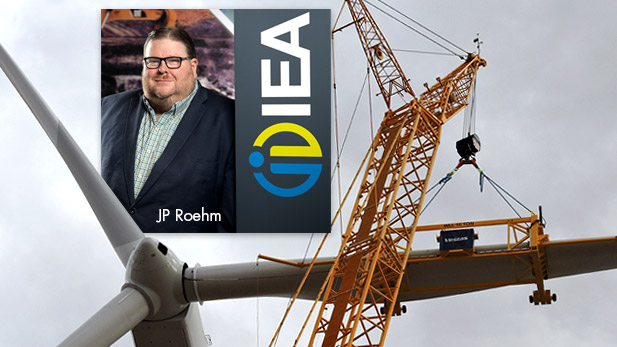Alumnus JP Roehm Helping Transform America’s Energy Landscape

As president and chief executive officer of Infrastructure and Energy Alternatives Inc., civil engineering alumnus JP Roehm is leading a provider of construction and logistical services specializing in the renewable energy sector.
Imagine using an enormous crane weighing about 1,000 metric tons to stand up a 200-ton cylindrical tower that’s taller than the Statue of Liberty. On top of that tower, you have to add a massive 56-ton box containing gears and a generator. Then, attach to that an immense rotor sprouting three sweeping blades, each measuring about 190 feet in length. And, finally, imagine assembling all these components in the middle of a cornfield on a windy day.
This is just part of the logistical ballet involving scores of skilled workers and millions of dollars in equipment that goes into assembling just one of the tens of thousands of wind turbines now operating across the United States. From small clusters featuring just a handful of turbines to massive wind farms stretching from horizon to horizon, these colossal machines are currently generating enough power to serve 32 million American homes.
And more are certainly on the way.
After 170 years of dependence upon fossil fuels, the U.S. is starting to pivot to carbon-free, renewable sources of energy, says 1997 civil engineering alumnus JP Roehm, president and chief executive officer of Infrastructure and Energy Alternatives (IEA) Inc., an Indiana-based provider of construction and logistical services specializing in the renewable energy sector.
“Coal and carbon are kind of a thing of the past, no matter your politics,” he says. “Renewables [even on a nonsubsidized basis] are the cheapest form of electrical generation today.”
By the start of 2020, renewable energy sources—incorporating wind, hydropower and solar power—produced nearly 18% of all U.S. electricity, according to the U.S. Energy Information Administration. The biggest share of that, accounting for 42%, belongs to wind power, which generates about 7% of total U.S. electricity, up from a mere 2% in 2010.
Despite a hiccup in production this year caused by supply chain interruptions linked to the COVID-19 pandemic, the outlook for wind energy continues to look rosy. Globally, the International Energy Agency reports renewables of all kinds will eclipse coal as the world’s biggest source of power in just five years, thanks in part to rapidly falling prices. For example, the cost of building large wind farms has declined 40% since 2010 and solar production costs have fallen by 80%.
Since entering the renewables business in 2004 when then-owner Herman White realized his company’s equipment was perfectly suited to erect wind turbines, IEA, then known as White Construction, has been riding a tremendous wave of growth. Company revenues increased by a factor of eight between 2004 and 2011, says Roehm, who joined White Construction full time after graduation. Now, with two-thirds of its business stemming from renewables, IEA, which went public two years ago (NASDAQ, IEA), is continuing to grow. More than $900 million in renewable energy revenue is anticipated in 2020.
“I’m proud we’ve been able to build a small public company here in Indiana the right way, with a team that’s been together for many, many years,” says Roehm, whose father, John Roehm, worked for White Construction for 50 years, retiring as a vice president and chief estimator in 2014. “That’s what construction is…bringing a lot of talented people together for a common cause.”
While its jobs span the country, including wind turbines in Hawaii, soon IEA will be working much closer to home for the company president, who splits his residence between Indianapolis and his hometown of Clinton, Indiana. IEA recently won a contract to build a $100 million, 302-megawatt wind farm in northern Indiana, an area of flat prairies ideally suited for strong breezes. The project will generate enough electricity to serve more than 83,000 homes.
Coal remains the main source of electrical power in Indiana at 59%, but the fossil fuel is losing its dominance elsewhere in the Midwest. In Iowa, for example, wind now accounts for 42% of power generation, compared to 35 percent for coal. In Kansas, wind now accounts for 41% of power generation, likewise relegating coal to No. 2 status.
Across the U.S., the same trend is evident as aging coal plants continue to close and are replaced either by natural gas facilities or renewables, and IEA seems poised to ride this trend. The company, with more than 20 gigawatts of renewable energy projects in 36 states under its belt, was recently ranked No. 2 for wind energy construction by Engineering News-Record, a trade publication.
All this is gratifying to Roehm, who says he detects a sense of pride among the people in his industry as they help turn the page to a cleaner source of power.
“We’re changing the world,” says Roehm, a member of the American Wind Energy Association’s board of directors. “We’re part of this massive conversion from a carbon-based form of generation to a green form of generation. That will provide dividends for generations to come.”
---------------
Wind Energy Basics
• A single wind turbine can produce enough electricity to power more than 460 homes.
• Utility-grade wind turbines have gotten much taller and more efficient in the past 10 years. In 2000, turbines typically stood about 180 feet and generated about 750 kilowatts of power. Today, turbines often reach 500 feet and generate 7,500 kilowatts of power.
• About 3,000 new turbines have been installed annually in the U.S. since 2005, with 120,000 people employed in the growing sector.
• Wind turbines are replacing carbon-producing sources of power. According to the American Wind Energy Association (AWEA), the electricity generated by wind turbines in 2019 alone replaced an estimated 42 million cars’ worth of CO2 emissions.
• The AWEA reports that the typical wind project repays its carbon footprint in six months or less and provides decades of zero-emission energy.